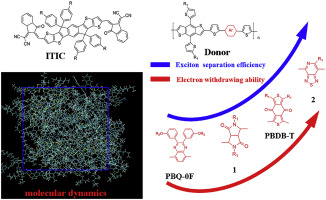Organic Electronics ( IF 2.7 ) Pub Date : 2017-11-03 , DOI: 10.1016/j.orgel.2017.11.002 Qing-Qing Pan , Shuang-Bao Li , Yong Wu , Yun Geng , Min Zhang , Zhong-Min Su

|
Recently, the non-fullerene acceptor ITIC has attracted a lot of attention in terms of its prominent performance in organic solar cell (OSC). A better match with the donor materials is critical for it, so we on one hand compared the match of two typical donors PBDB-T and PBQ-0F with ITIC trying to find the main difference between them. On the other hand, we designed two donors 1 and 2 based on the same 2D-BDT unit and estimated their cell efficiency aiming to explore more effective donors for ITIC. The molecular dynamics simulation was carried out to get more practical photovoltaic interface, and the density functional theory was employed to estimate the cell efficiency. It is found that PBDB-T not only exhibits higher charge separation efficiency depending on larger charge separation and smaller charge recombination rates than PBQ-0F, but also displays stronger electron-hole coherence from donor to acceptor fragments at its S1 state than PBQ-0F indicating its easier exciton dissociation at excited states. The stronger electron-withdrawing ability of the acceptor fragment in PBDB-T is concluded to make the main contribution to its higher charge separation efficiency, which is further proved by our designed donors 1 and 2. Molecule 2 with stronger electron-withdrawing ability of the acceptor fragment than PBDB-T shows better charge separation performance at the interface than PBDB-T, which again suggests introducing strong electron-withdrawing group in this kind of donors may be a good choice for improving the performance of organic solar cell using ITIC as acceptor.
中文翻译:

通过提高吸电子能力,探索有机太阳能电池中著名的非富勒烯受体ITIC的更有效的聚合物供体
最近,非富勒烯受体ITIC就其在有机太阳能电池(OSC)中的出色表现引起了很多关注。与供体材料的更好匹配对它至关重要,因此我们一方面将两种典型供体PBDB-T和PBQ-0F的匹配与ITIC进行了比较,试图找出两者之间的主要区别。另一方面,我们基于相同的2D-BDT单元设计了两个供体1和2,并估计了它们的细胞效率,旨在为ITIC探索更有效的供体。进行了分子动力学模拟以获得更实用的光伏界面,并采用密度泛函理论估算了电池效率。可知PBDB-T不仅取决于较大电荷分离和电荷较小重组率比表现出更高的电荷分离效率PBQ-0F,而且在它的S显示从供体到受体的片段更强的电子-空穴相干1状态下比PBQ- 0F表示其在激发态下更容易激子解离。PBDB-T中受体片段的较强吸电子能力结论是对其较高的电荷分离效率做出了主要贡献,这一点已由我们设计的供体1和2进一步证明。分子2具有比受体片段的强吸电子能力PBDB-T示出了在比界面更好的电荷分离性能PBDB-T ,这再次表明在这种供体的引入强吸电子基团可以是用于改善一个很好的选择使用ITIC作为受体的有机太阳能电池的性能。











































 京公网安备 11010802027423号
京公网安备 11010802027423号